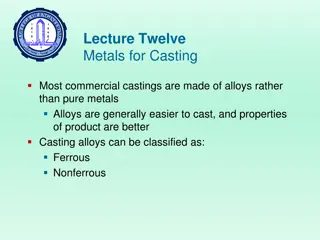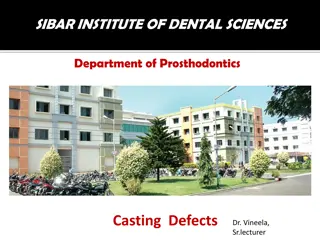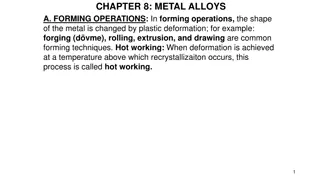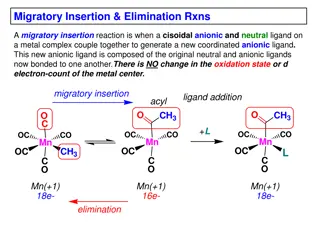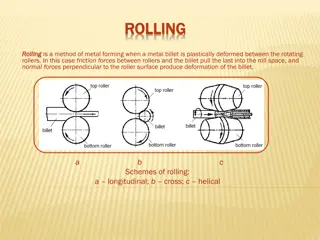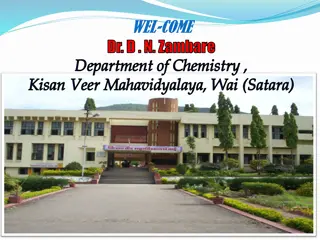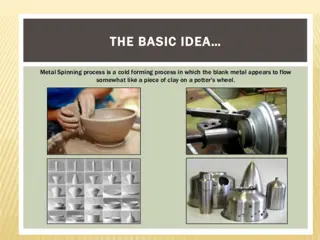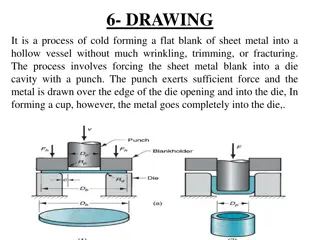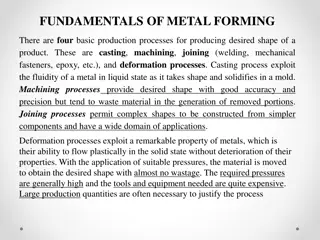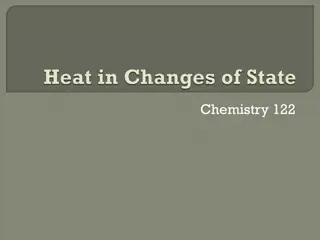Understanding Solidification Process in Metal Casting
Solidification in metal casting involves nucleation and growth processes, impacting the final product's quality. Factors such as type of metal, thermal properties, and mold shape influence solidification. Homogeneous nucleation occurs below the equilibrium freezing point, while heterogeneous nucleation relies on foreign particles. Crystals grow by consuming the melt, impacting casting quality.
Download Presentation

Please find below an Image/Link to download the presentation.
The content on the website is provided AS IS for your information and personal use only. It may not be sold, licensed, or shared on other websites without obtaining consent from the author. Download presentation by click this link. If you encounter any issues during the download, it is possible that the publisher has removed the file from their server.
E N D
Presentation Transcript
Solidification When molten metal enters a mold cavity, its heat is transferred through the mold wall. In the case of pure metals and eutectics, the solidification proceeds layer-by- layer (like onion shells) starting from the mold wall and proceeding inwards. The moving isothermal interface between the liquid and solid region is called the solidification front. Solidification includes two processes: nucleation and growth. 1- Nucleation and Growth When liquid metal is poured into a mold and allowed to cool, a series of complex events takes place. The significant factors are the type of metal (whether it is a pure metal or an alloy), thermal properties (thermal conductivity and specific heat), the geometric relation between volume and surface area of the liquid metal, the shape of the mold, and the mold material. Many casting defects, such as porosity and cavities, depend on the manner in which the alloy is solidified in a mold. Basically the reason of molten metal solidification is that the arrangement of the atoms in the solid crystal is at a lower free energy than that of the same atoms in a liquid state.Above the freezing point, however, the liquid state is more stable.At the freezing point there is no driving force in either direction; in other words, the change in free energy is zero, and we have equilibrium. The further the metal is cooled below the liquid-solid equilibrium temperate, the greater is the driving force to solidify. The first step of solidification is the nucleation, and there are two types of nucleation: homogenous and heterogeneous'. 1
Homogenous Nucleation The temperature at which homogenous nucleation occurs is always below the equilibrium freezing point because it is necessary to overcome the surface-tension forces which impede nucleus growth. The energy tending to produce a nucleus of solid is the difference in free energy per unit of volume between the liquid and solid phases. In the general case of freezing within the bulk of pure molten metal, minute crystalline nuclei form independently at random points.After this homogeneous form of nucleation, continued removal of thermal energy from the system causes these nuclei to grow independently at the expense of the surrounding melt. Throughout the freezing process, there is a tendency for bombardment by melt atoms to destroy embryonic crystals; only nuclei which exceed a critical size are able to survive. Rapid cooling of pure molten metal reduces the time available for nuclei formation and delays the onset of freezing by temperature interval of ( T). This thermal under-cooling (or suppercooling), varies in extent, depending upon the metal and conditions, but can be as much as (0.1- 0.15) Tm, where Tm is the absolute melting point. However, commercial melts usually contain suspended insoluble particles of foreign matter (e.g. from the refractory crucible or hearth) which act as seeding nuclei for so-called heterogeneous nucleation. Undercooling is much less likely under these conditions. Homogeneous nucleation is not encountered in normal foundry practice. Heterogeneous Nucleation Most actual castings crystallize by heterogeneous nucleation, the basic reason being that if the new phase can find a foreign particle to grow upon, it can in effect adopt the relatively large radius of the particle as its own. This means that only a 2
slight degree of super cooling is needed in comparison with that needed in homogeneous nucleation. Quantitatively, the relation depends upon the degree to which the new phase wets the foreign particle. If there is no attraction between the atoms of the foreign particle and those of the precipitating phase, then nucleation is not helped. The wall of a mold usually provides many heterogeneous nucleation sites. The best nucleus, of course, is a particle of the precipitate itself. For example, it is possible to grow large single crystals of metals by introducing a small crystal of the metal itself into a melt as it cools through the freezing temperature. Growth The growing crystals steadily consume the melt and eventually impinge upon each other to form a structure of grains. During the freezing of many metals (and alloys); nucleated crystals grow preferentially in certain directions, causing each growing crystal to assume a distinctive, non-faceted tree-like form known as a dendrite.As each dendrite spike grows, latent heat is transferred into surrounding liquid, preventing the formation of other spikes in its immediate vicinity. The spacing of primary dendrites and dendrite arm therefore tends to be regular. Ultimately, as the various crystals impinge upon each other, it is necessary for the interstices of the dendrites to be well-fed with melt if inter-dendritic shrinkage cavities are to be prevented from forming. Solidification of Metals and Alloys The solidification divided into three types: 1-At constant temperature (pure metals and eutectic alloys) 3
2-Over a temperature range (solid solutions) 3-By a combination of solidification over a temperature range followed by constant temperature freezing (proeutectic-plus eutectic type freezing).The solidification process differs depending on whether the metal is a pure element or an alloy. Solidification of Pure Metals A pure metal solidifies at a constant temperature equal to its freezing point, which is the same as its melting point. The melting points of pure metals are well known and documented. The process occurs over time as shown in the plot of figure (A), called a cooling curve. The actual freezing takes time, called the local solidification time in casting, during which the metal's latent heat of fusion is released into the surrounding mold. The total solidification time is the time taken between pouring and complete solidification.After the casting has completely solidified, cooling continues at a rate indicated by the downward slope of the cooling curve. Solidification of Alloys Most metals used for technical applications are alloys, i.e., mixtures composed of several chemical components. The solidification of alloys differs in three principal ways from that of pure metals: 1-Usually, the freezing of alloys occurs over a temperature range. Most alloys freeze over a temperature range rather than at a single temperature. The exact range depends on the alloy system and the particular composition. Solidification of an alloy can be explained with reference to figure (B) which shows the phase diagram for a particular alloy system and the cooling curve for a given composition. As temperature drops, freezing begins at the temperature 4
indicated by the liquidus and is completed when the solidus is reached. The start of freezing is similar to that of the pure metal. 2-The composition of the solid which separates first is different from that of the liquid. 3-There may be more than one solid phase crystallizing from the liquid. Figure ( A) Cooling curve for a pure metal during casting Solidification Mode Alloys can be classified into three types based on their freezing ranges: Short freezing range : liquidus- to- solidus interval < 50oC Intermediate freezing range : interval of 50 to 110oC 5
Long freezing range : interval > 110oC Figure (B) (a) Phase diagram for a copper-nickel alloy system and (b) associated cooling curve for a 50%Ni-50%Cu composition during casting. The first group consists of the pure metals and alloys which are 100% eutectic, in which the freezing range approaches zero, the solidifying casting wall (solidification front) progresses inward as a plane front and is almost smooth as shown in figure (C). Short freezing range alloys are closely similar but in these instances the front is not perfectly plain but is serrated as illustrated in figure (D), which shows a strong tendency toward skin formation, and the front of the crystals solidifying inward (start of freeze) will not advance much faster than their bases (end of freeze). Such relative, short crystalline growth helps keep liquid feed metal in contact with all solidifying surfaces. Such strong progressive solidification in these short freezing range alloys promotes the development of directional solidification along any temperature gradients in the solidifying casting figure (D). 6
For long freezing range alloys, the development of directional solidification is difficult.Although a thin skin may initially form on the mold walls, almost as soon as the crystallites are formed, their growth becomes drastically inhibited. The first- formed crystals are much lower in alloying elements than the liquid metal from which they are formed. Hence many of the atoms of alloying elements present in the liquid metal from which crystallites are formed are expelled into the liquid surrounding the crystallites. These surrounding liquids thus become enriched in alloying element and this enrichment considerably depresses the freezing point of the liquid. If freezing were very slow, so that ample time is available for diffusion of the excess atoms from this enriched layer of liquid into remainder of the liquid metal, the crystallites would continue to grow and a columnar structure would result. However, in most practical situations there is not nearly sufficient time for these concentrations in the liquid to be dissipated by diffusion so that the liquid metal surrounding the crystallites is unable to freeze till a much later stage during freezing of the casting as a whole.As illustrated in figure (E), the material at first being fluid, then mushy and finally rigid, It has been estimated that in many alloys, rigidity is not established until the casting is about 60-70% solid. This mushy or pasty mode of solidification results in the development of numerous small channels of liquid metal late in solidification. Feeding through these channels is restricted, and dispersed shrinkage porosity occurs throughout the casting. For alloys with an intermediate freezing range, the mode of solidification will combine elements of both the skin-forming and mushy solidification mode as shown in figure (F). Short freezing range alloys may shift to a more intermediate mode of solidification in heavy casting section, in which heat loss from the casting surface will be slowed as the molding medium heats up. 7
Fig.(C) Mode of Pure Metal Fig .(D) Short Freezing Range Fig. (E) Intermediate Freezing Mode Fig. (F) Long Freezing Mode 8







